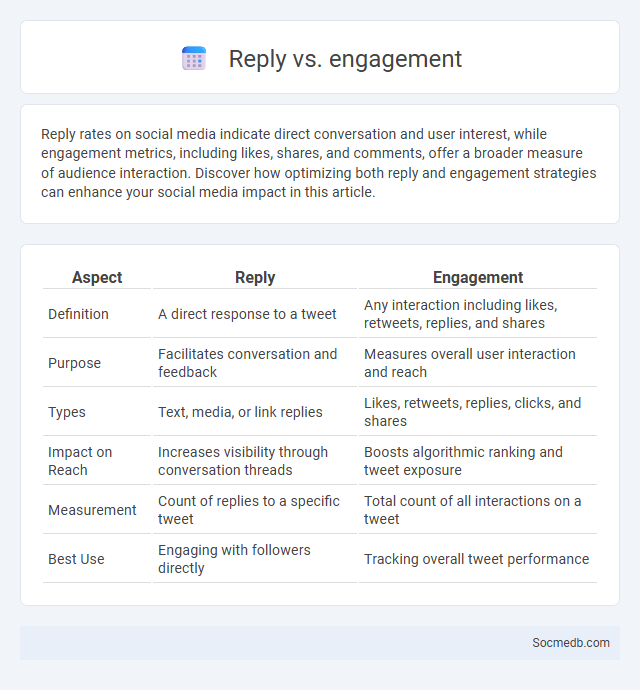
Photo illustration: Reply vs Engagement
Reply rates on social media indicate direct conversation and user interest, while engagement metrics, including likes, shares, and comments, offer a broader measure of audience interaction. Discover how optimizing both reply and engagement strategies can enhance your social media impact in this article.
Table of Comparison
| Aspect | Reply | Engagement |
|---|---|---|
| Definition | A direct response to a tweet | Any interaction including likes, retweets, replies, and shares |
| Purpose | Facilitates conversation and feedback | Measures overall user interaction and reach |
| Types | Text, media, or link replies | Likes, retweets, replies, clicks, and shares |
| Impact on Reach | Increases visibility through conversation threads | Boosts algorithmic ranking and tweet exposure |
| Measurement | Count of replies to a specific tweet | Total count of all interactions on a tweet |
| Best Use | Engaging with followers directly | Tracking overall tweet performance |
Understanding Reply: Definition and Importance
Understanding reply in social media refers to the action of responding directly to a comment, post, or message, which fosters meaningful interaction and engagement among users. Your ability to effectively craft replies can enhance communication, build relationships, and increase visibility within online communities. Recognizing the importance of replies helps leverage social platforms for personal branding, customer service, and audience growth.
What Is Engagement? A Clear Overview
Engagement on social media refers to the measurable interactions between your content and your audience, including likes, comments, shares, and clicks. It reflects the level of interest and connection that your followers have with your posts, serving as a key indicator of content effectiveness and audience loyalty. Maximizing engagement helps you build a stronger community and increase the visibility of your brand across platforms.
Reply vs Engagement: Key Differences
Reply refers to a direct response to a specific comment or message on social media, fostering one-on-one interaction. Engagement encompasses a broader range of user interactions, including likes, shares, comments, and replies, indicating overall interest in your content. Understanding the difference between reply and engagement helps you tailor your social media strategy to boost meaningful conversations and increase audience participation.
Types of Reply: Active and Passive
Social media interactions are characterized by two primary types of replies: active and passive. Active replies engage directly with content through comments, shares, or detailed feedback, fostering dynamic conversations and higher user involvement. Passive replies involve non-verbal acknowledgments such as likes or emojis, signaling approval or interest without extended interaction, which helps measure audience sentiment and content reach.
Metrics to Measure Engagement Effectively
Key social media metrics to measure engagement effectively include likes, comments, shares, and click-through rates, which provide insight into content resonance and audience interaction. Tracking follower growth and post reach helps gauge the overall visibility and appeal of the content. Analyzing conversions and user-generated content further reveals the impact on brand loyalty and community building.
How Replies Influence Online Engagement
Replies on social media significantly boost online engagement by fostering direct interaction between users and content creators, encouraging meaningful conversations that increase visibility through algorithms prioritizing active discussions. When you respond to comments, your profile gains higher reach and retains audience attention, enhancing community loyalty and content relevance. Data from platforms like Instagram and Twitter show posts with frequent replies receive up to 70% more interactions, highlighting the critical role of responsive communication in digital marketing strategies.
The Role of Timely Replies in Engagement Rates
Timely replies on social media significantly boost engagement rates by fostering real-time interactions and enhancing user satisfaction. Quick responses increase the likelihood of continued conversations, building stronger brand loyalty and trust. Studies show that brands replying within an hour see up to 70% higher engagement compared to those with delayed responses.
Engagement Strategies Beyond Replies
Effective social media engagement strategies extend beyond simple replies by leveraging interactive content such as polls, quizzes, and live videos to foster deeper user participation. Utilizing personalized messaging and user-generated content campaigns encourages community building and amplifies brand loyalty. Employing analytics to tailor content timing and format further maximizes audience interaction and sustained engagement.
Common Mistakes: Replying Without Engagement
Replying without genuine engagement on social media often leads to missed opportunities for building authentic connections and trust with your audience. Automated or generic responses can make your interactions feel impersonal and reduce overall user satisfaction. Ensuring your replies demonstrate understanding and relevance enhances your social media presence and fosters meaningful conversations.
Choosing the Right Approach: When to Prioritize Reply or Engagement
Choosing the right approach in social media depends on whether your goal is to build personal connections or increase overall visibility. Prioritize replying when you aim to nurture customer relationships, resolve inquiries, or provide personalized support, as timely responses boost trust and loyalty. Your engagement strategy should focus on likes, shares, and comments to expand reach, attract new followers, and enhance brand awareness across platforms.
 socmedb.com
socmedb.com